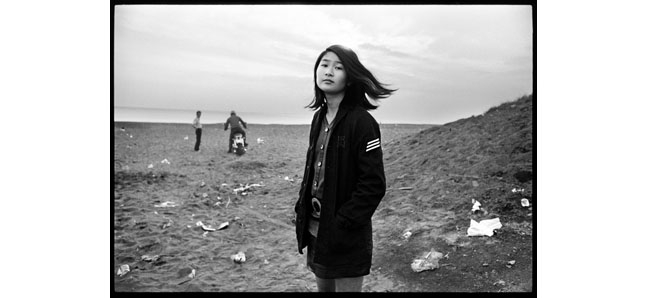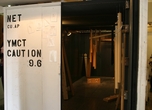Herbie’s shutter blink
‘It’s not about love; it’s about taking many photos to get just one’

Posted: Thu Oct 21 2010
Currently on at Shinagawa’s Canon Gallery-S is ‘Herbie Yamaguchi: 1970, Hatachi no Shoukei’, a photography exhibition by photographer Herbie Yamaguchi. On show are 70 never-seen-before monochrome photos taken between 1969 and 1973 when Yamaguchi was in his twenties. We asked Yamaguchi why he had only now decided to exhibit photos that were taken forty years ago.
Why did you decide to show photos that were taken forty years ago?
HY: Forty years ago. It’s amazing, isn’t it. That’s before you were born. [Laughs] It all started when I found 400 negatives of photos that I had taken during my university days when I was about 23 or 24, in relatively good shape in an Izumiya cookie tin. They were taken before I went to London so I was a novice and I really didn’t think they would be any good. However, among them was a photo that was the starting point all of my photos. One day, as I was taking a photo of a girl playing volleyball, the ball looked as though it was going to hit me. The girl didn’t want it to hit me and with her gentle eyes she was saying, ‘I’m sorry if it hurts’. At that moment, I thought to myself, I want to travel around the world and take photos of gentle eyes like these. This was the beginning of my photos.
When you printed out the photos did you find that they were really the starting point? Were there any that seemed more beautiful?
HY: They were good photos just like I had always remembered them to be. There was the photo of the volleyball girl, the student movement, and there were also photos of Okinawa before it was returned to Japan. However, they have a completely different perspective to the photos I take now. I try to capture the positive moments of being human.
You see, when I was a young boy, I suffered from carious disease and I had to be in a corset all the time. I was a young boy who couldn’t participate in sports classes, was lonely and without hope. The spring finally came when I was around 18 years old and I was cured. I became a university student and when I went out with my camera trembling in fear into the streets, everything that caught my eyes was amazing and glorious. Whether it was young boys or young girls or demonstrators, or a grandmother with her arms around her grandchild, everybody looked radiant. I captured that radiance without using any tricks and without letting my mind stray. I think they are really fresh. I really wanted to show this to the world.
You have always taken monochrome photos and don’t crop them, is that right?
HY: Not changing one’s style in one way of being a photographer. There are some people who change their style photo by photo but not changing my style throughout the 40 years is my way of life. There are trends, and ways of expressing oneself in photos and music changes. But I want to demonstrate that not changing is part of a bigger picture.
The other day I met a student doing photography. The student told me that because recently the students have been looking at abstract expressionism all of the students want to take abstract photos for their graduation piece. They are putting aside what they really want to create, what they really want to do from the bottom of their heart, trying to be critiqued. They think doors will open to them as a creative person by ignoring their inner voice. This is preposterous. First of all the starting point is one’s heart. If their heart is in fitting with the times, then things will go well. If it isn’t, one has to work hard to get noticed. Just following trends is not the right path for an artist to take. Artist can’t be just reproducing what’s trendy. I want to get this message across to young people.
In this exhibition, I want people to look back fondly at the 70s. While there may not be any new artistic expressions, I want young people to know what the road of making art filled with spirit is like.
Have there been any subjects recently that have left an impression on you?
HY: Takashi Yanase; the writer of ‘Anpan Man’. You know that song. It goes ‘Your warm heart is burning with life. So you’ll go with a smile,’ Then it continues like this ‘That’s right. Don’t be afraid. All you need is love and courage because we are all friends,’ Yanase told me that this song was for the Kamikaze units. His brother was in one of these units and was killed. When kids sing this song they are smiling, but it made me cry when I thought about its meaning. It is important to have meaning in photos too. All one needs to do is push a button to take a photo these days, but I want each of my photos to tell a story.
So when do you want to take photos?
HY: When I am moved by the radiance of my subjects. I never know when the right opportunity to take a photo might come up. Whether it’s people trying to survive in an area devastated by an earthquake, or an old lady going up the stairs in the building where which houses a photo shop. There are emotions that have a big impact.
In the past I put together a collection of photos called ‘Hope’ amongst which is a photo of elementary school kids going to school. You see that photo, might just seem like a regular snap but everyday for six years I went with these kids on their way to school. This is the only good opportunity I had to take a photo. It was an opportunity that came by sheer luck. It also has an honest energy coming from taking photos everyday for six years. I don’t know when I might have that chance again, so all I can do is take photos wherever and whenever I am moved.
What is the difference between how your subjects are now and how they used to be?
HY: Over 40 years without anyone even realising it, people have lost their trust in others and have forgotten how to be kind to each other. In the past you could take photos freely, but now, it is much more difficult to take them. When I was young I would do things like go to a girl’s school without permission to take photos. Because people trusted each other; no one thought that the photos would be used for anything bad. Now you might be sued. But back then people would say ‘He’s that type of person’. [Laughs]
You were popular, weren’t you. [Laughs]
HY: Now I try to take care about being fashionable. I go to Boy in Daikanyama to get my hair cut. It’s my friend who I know from when I used to take photos in London. I’ll introduce you!
‘Herbie Yamaguchi: 1970, Hatachi no Shoukei’
Tweets
- About Us |
- Work for Time Out |
- Send us info |
- Advertising |
- Mobile edition |
- Terms & Conditions |
- Privacy policy |
- Contact Us
Copyright © 2014 Time Out Tokyo













Add your comment